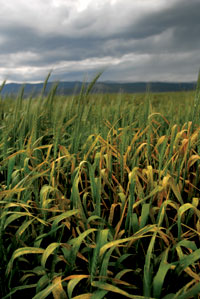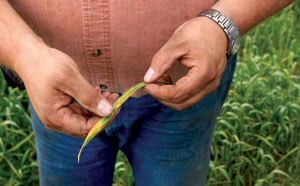Exacerbated by cool and damp weather, a fungal disease called stripe rust has spread across the Pacific Northwest’s croplands, threatening significant losses in wheat during a growing season that began with high hopes for above-average yields.
Farmers in Montana and neighboring states have been forced to spend many thousands of dollars on fungicide to combat what wheat producer Dan Brosten says is the worst outbreak of stripe rust he’s experienced in a career spent farming in the Flathead Valley.
“In 25 years, I haven’t seen it like this,” he said. “These cold, moist days are a greenhouse, if you will, for rust.”
Bob Stougaard, professor of weed science at Montana State University’s Northwestern Agricultural Research Center in Kalispell, wonders if it’s a new strain. Research plants at his nursery that had previously proven fairly resistant are experiencing “high infection” this year. He described the rust as “epic.”
“I suspect we might have a new race in the area,” Stougaard said. “If we have a new race, that means that varieties that were rated as resistant or tolerant may not have that type of classification and we have to look for new varieties to potentially grow in this area.”
And now, just as Brosten and other producers in the region are getting the stripe rust under control, they’re turning their attention to another nemesis: orange wheat blossom midges, which can be devastating. Farmers will know soon if midges are going to be a problem, but Brosten said the moisture hasn’t helped matters.
“We’re on watch,” he said.
Following a prolonged battle with stripe rust in wheat-heavy Central Montana, farmers are preparing for another potential fungal disease as the weather warms, according to Joe Broesder, MSU extension agent for Hill County.
“We could be going from one rust to another,” Broesder said.
 |
|
Winter wheat, colored by a fungal disease called stripe rust, is seen in Dan Brosten’s Lower Valley wheat field. |
So many crop dusters were used in fighting stripe rust in Central Montana that additional planes had to be called in from out of state, Broesder said.
“It was lining up to be a better-than-average year for yield potential, but now it’s really hard to know until things start coming up,” he said. “I think a lot of the producers got sprayed in time. We’ll see.”
While strip rust is nothing new to farmers in Montana, this year’s case is especially troublesome due to a “perfect storm” of circumstances, according to Markus Braaten, an agronomist with CHS Kalispell.
First, there were already pathogens throughout the area. Then the virulent strain “overwintered,” meaning it survived the winter months. Finally, the climate stayed cool and wet into summer, ushering in perfect conditions for the stripe rust to quickly spread. Wind could have blown more in as well, Broesder said.
Winter wheat has been hardest hit, though spring wheat is also a concern.
“It’s definitely a significant problem and hopefully one that’s beginning to ebb and not build,” Braaten said.
“Once it got established, it really ran hard,” he added. “It went from trace levels of infection to significant levels in a week or a little more than a week.”
Management efforts, such as widespread fungicide applications, have slowed the spread to the point where “we’re probably on the verge of having it handled,” Braaten said. Warmer temperatures are helpful too.
“The best thing would be for it to dry out and get hot,” he said last week as the weather was beginning to do just that.
The damage may have already been done for many farmers, though the extent won’t be known until harvest. Braaten has heard of some cases where up to 60 percent of the flag leaf tissue on wheat plants has been compromised. The flag leaf is vital for photosynthesis, which builds the grains.
“There’s going to be some reduced yields for sure,” Braaten said.
Brosten, who has over 1,000 acres in Lower Valley south of Kalispell, said he sprayed fungicide on his winter wheat in May but then noticed stripe rust in early June. He was forced to spray again and also treat his spring wheat and barley, which was starting to show symptoms of disease.
 |
|
Dan Brosten holds a leaf from a winter wheat plant showing signs of stripe rust. |
Using a mid-priced treatment product, Brosten said spraying costs $20 an acre. But, with so much money already invested, farmers have no choice but to do what it takes to save their crops.
“It’s added a lot of cost,” Brosten said. “If you do a thousand acres, that’s $20,000 added to what you’re doing. Then you do it two, three times.”
Brosten seems to have stopped the disease’s spread with fungicide, but he’s unsure how much of his harvest will ultimately be lost.
“Typically rust can cut your yield 20 to 30 percent,” he said. “If it doesn’t get treated, it can totally take the crop.”
Moisture has also impeded farmers’ ability to plant in a timely fashion and run heavy machinery on the wet ground, while affecting home gardeners and orchard owners as well.
On a brighter note, Pat McGlynn, MSU agriculture extension agent for Flathead County, said cherry and apple crops look strong, even if their harvest may be pushed back a few days. Also, McGlynn said hay growers in Montana could be in for another highly productive season.
“I think we might have another bumper crop like last year,” McGlynn said.